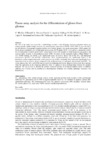Mostrar o rexistro simple do ítem
Tissue array analysis for the differentiation of gliosis from gliomas
| dc.contributor.author | Medina Villaamil, Vanessa | |
| dc.contributor.author | Álvarez García, A. | |
| dc.contributor.author | Aparicio Gallego, Guadalupe | |
| dc.contributor.author | Díaz-Prado, Silvia | |
| dc.contributor.author | Rivas López, A. | |
| dc.contributor.author | Santamarina, Isabel | |
| dc.contributor.author | Valladares-Ayerbes, Manuel | |
| dc.contributor.author | Antón-Aparicio, Luis M. | |
| dc.date.accessioned | 2015-06-16T08:33:32Z | |
| dc.date.available | 2015-06-16T08:33:32Z | |
| dc.date.issued | 2011-03-22 | |
| dc.identifier.citation | Medina Villaamil V, Alvarez García A, Aparicio Gallego G, Díaz Prado S, Rivas López LA, Santamarina Caínzos I, Valladares Ayerbes M, Antón Aparicio LM. Tissue array analysis for the differentiation of gliosis from gliomas. Mol Med Rep. 2011 May-Jun;4(3):451-7. | es_ES |
| dc.identifier.uri | http://hdl.handle.net/2183/14681 | |
| dc.description.abstract | [Abstract] The aim of this study was to provide a methodology to make a clear distinction between malignant tumors and morphologically similar benign processes, by examining the expression of EGFR, VEGF, HIF1-α, survivin, Bcl-2 and p53 proteins. Four groups of patient samples were studied: group 1, low-grade astrocytomas (WHO grades I-II) (n=6); group 2, peripheral area of high-grade astrocytomas (WHO grades III-IV) (n=5); group 3, gliomatosis cerebri (n=11); and group 4, reactive gliosis (n=6). Tissue arrays (TAs) were designed to study apoptosis, angiogenesis and invasion-related proteins by immunohistochemistry (IHC). By means of non-parametric analysis (Mann-Whitney U test), EGFR staining was shown to be significantly lower in reactive gliosis than in the low- and high-grade astrocytomas (p=0.015 and p=0.030, respectively); Bcl-2 immunoreactivity was significantly higher in the gliomatosis cerebri samples than in the reactive processes (p=0.005); and finally, Bcl-2 presented significantly lower expression levels in reactive gliosis compared to the peripheral areas of high-grade astrocytomas (p=0.004). The results indicate that Bcl-2 and EGFR may be useful in conducting differential diagnosis between the above groups, while the expression of the remaining antibodies does not appear to aid in distinguishing between the samples analyzed. The use of TAs to identify the protein expression profiles of biological markers related to different pathways was verified, and its potential as a discriminatory technique for everyday pathology procedures was demonstrated. | es_ES |
| dc.language.iso | eng | es_ES |
| dc.publisher | Spandidos | es_ES |
| dc.relation.uri | http://dx.doi.org/10.3892/mmr.2011.462 | es_ES |
| dc.subject | Astrocytomas | es_ES |
| dc.subject | Bcl-2 | es_ES |
| dc.subject | Epidermal growth factor receptor | es_ES |
| dc.subject | Gliomastosis carebri | es_ES |
| dc.subject | Reactive glosis | es_ES |
| dc.subject | Survivin | es_ES |
| dc.subject | Tissue array | es_ES |
| dc.title | Tissue array analysis for the differentiation of gliosis from gliomas | es_ES |
| dc.type | info:eu-repo/semantics/article | es_ES |
| dc.rights.access | info:eu-repo/semantics/openAccess | es_ES |
| UDC.coleccion | Investigación | es_ES |
| UDC.departamento | Fisioterapia, Medicina e Ciencias Biomédicas | es_ES |
| UDC.grupoInv | Grupo de Investigación en Terapia Celular e Medicina Rexenerativa (TCMR) | es_ES |
| UDC.grupoInv | Terapia Celular e Medicina Rexenerativa (INIBIC) | es_ES |
| UDC.institutoCentro | INIBIC - Instituto de Investigacións Biomédicas de A Coruña | es_ES |
Ficheiros no ítem
Este ítem aparece na(s) seguinte(s) colección(s)
-
Investigación (FCS) [1284]






